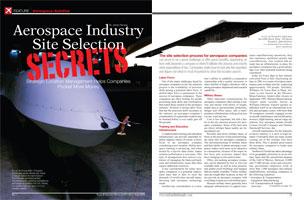
The site selection process for aerospace companies can prove to be a great challenge or offer great benefits, depending on how well prepared a company is when it initiates the process and exactly what expectations it has. Companies really have to look into the operation and figure out what is most important to drive the location search.
Labor Force
One of the major challenges faced by aerospace companies in the site selection process is the availability of precision skills among a potential labor force. A skilled labor force is paramount to the success of aerospace companies. These companies are often looking for people possessing deep skills and certifications that match those needed in the aerospace industry. Without a strong labor force that has the precision skills necessary in the industry, an aerospace company’s consideration of a particular location may be doomed before it ever really gets off the ground.
Training and Education Infrastructure
A sophisticated training and education infrastructure can provide important industry support, which, of course, is beneficial to an aerospace company considering a new location. Online aerospace training is advancing, and when hosted by a top-tier data center, makes systems performance a non-issue. This type of arrangement also relieves customers of managing the back-end hardware and infrastructure issues that often require additional resources.
A key consideration for many aerospace companies is a potential employment base that is able to meet the demands of world-class aircraft manufacturing and aerospace technology needs.
Another key consideration is a location’s ability to establish a cooperative relationship with a nearby university or other institute of higher education with a strong aerospace department and research capability.
Military Bases
Other important considerations for aerospace companies often include a runway and tarmac with plenty of length, ample area to accommodate production, hangar and office space, and a transportation infrastructure with good access via rail, road and sea.
Cost is less important, but still a factor in the site selection process for aerospace companies. Some of the best sites are where military bases nearby are being phased out.
Recently shut down military bases, or those in the process of decommissioning, are ideal sites for aerospace companies. The decommissioning of military bases and their ability to attract aerospace companies makes such areas more attractive to communities, because of the major labor force and economic impact they have, bringing in jobs and revenue.
Often, site-seeking aerospace companies can be attracted by free or low-cost available land, as well as reuse projects, and ample-sized buildings and hangars that are readily available. Former military sites are sought after locations, as they often provide an aerospace company with everything it needs at a rock-bottom price.
Because military bases generally have adequate infrastructure to support aerospace manufacturing operations, they can commence operations quickly and cost-effectively. Any location that already has an infrastructure in place for aerospace companies has a good advantage over other potential locations being considered.
Kelly Air Force Base in San Antonio converted from a fully functioning air base in 2001 to a center of aviation maintenance and overhaul activity, employing approximately 550 people. Similarly, Williams Air Force Base in Mesa, Arizona, is now known as the Phoenix-Gateway Airport after closure in September 1993. Phoenix-Gateway Airport (until recently known as Williams Gateway Airport) quickly established itself as an international aviation and aerospace center, with more than 30 companies currently engaged on-site in aircraft maintenance and modification, avionics, flight training, and air cargo operations. Key aerospace tenants include Cessna Aircraft Company and Hawker Beechcraft Services, Inc.
Aircraft maintenance for the domestic aviation industry is a skill in high demand. Fortunately there are many people coming out of the military who have these skills. This is another good reason for aerospace companies to locate near military bases.
Northwest Florida has taken advantage of its geographic proximity to seven military bases and the unrestricted airspace of the Gulf of Mexico. Between 32,000 and 37,000 private sector and non-military government employees work in more than 1,900 aerospace and defense establishments, including companies in the following industries:
Aerospace & Transportation Equipment Manufacturing
Air Transportation & Support Activities
Aviation Machinery and Equipment Distribution
Chemicals and Fuel Manufacturing and Distribution
Computers, Electronics & Electrical Equipment Manufacturing
Engineering, Testing, R&D & Industrial Design
Fabricated Metals and Machinery
Flight Training
I.T., Systems Integration, Network Solutions & Telecommunications.
San Antonio, for example, did a study that found there are many people skilled in aircraft maintenance who reside near Air Force bases. As a result, aerospace companies can potentially find many non-union skilled individuals who are available in the labor force.
Other types of plants, such as those dealing with electronics and parts do not necessarily have to be on an airfield. However, they do need to be in locations where they can serve a customer base.
Logistics
If an aerospace company like Boeing is manufacturing wing assemblies for planes, logistics is important. Manufacturing large parts like wing assemblies sometimes requires a water transportation location near a port for easy access and transportation needs.
When European Aeronautic Defence and Space (EADS) selected Mobile, Alabama, over three rival bids from Melbourne, Florida; Kiln, Mississippi; and North Charleston, South Carolina, Chairman Ralph Crosby said Mobile was chosen because it is “strategically located” on the Gulf of Mexico, and offers a skilled work force, airport runways and a deep-water port.
More and more aerospace projects are going to the government and are thus insulated against off shoring—such as homeland security and 9/11-related projects. Such a scenario makes the site selection process more stable. The process of deciding where contracts end up does become more political, as pressure builds up to place projects in communities where the company or its directors have political ties.
Information Technology Skill Sets
There also has been a recent trend toward creation of military and non-military applications of unmanned aircraft vehicles (UAVs). The MQ-1 Predator unmanned aircraft system (UAS) is manufactured by General Atomics in San Diego, California. The Predator System and similar aircraft can serve in either a reconnaissance role or actively as a military platform firing missiles at qualified targets.
The Predator, in use since 1995, has seen combat over Afghanistan, Pakistan, Bosnia, Serbia, Iraq and Yemen. Unmanned aircraft vehicles and systems require much more software and control systems engineering than earlier generation aircraft. In these industries, computer hardware and software, electrical engineering and other information technology skill sets are essential in the labor market. Educational systems that strongly support these disciplines will help attract this emerging industry.
Incentives Attract Interest
The reuse of former military facilities has been encouraged with the use of federal and state tax abatements. An aerospace company should look for any special federal and state zone that gives hiring credits (such as a state enterprise zone or a federal empowerment zone). These are designated areas where the company can get credits for hiring people and investing in those areas. In certain areas, aerospace companies can also get accelerated depreciation on their real estate, whereby they are able to write it off at a faster rate.
Many municipalities will offer a discount on land or buildings. There are also the possibilities of local, state and federal tax incentives. In many areas, if an aerospace company were to locate into a tax exempt zone, it can pick up some impressive tax incentives.
Defense Economic Readjustment Zones
There are also what are known as Defense Economic Readjustment Zones. This program was established as a tool for business recruitment and job creation in adversely impacted defense dependent communities. It is designed to provide assistance to communities, businesses and workers impacted by, or vulnerable to, the closure or realignment of military installations and the reduction in federal defense contracting expenditures.
The incentives offered through the Defense Economic Readjustment Zone are similar to the Enterprise Zone Program. An Enterprise Zone is an economic development tool that allows a community to partner with the state to offer a package of local and state tax and regulatory benefits to assist businesses seeking to locate, expand or retain jobs in economically distressed areas. Through the Enterprise Zone Program, state sales tax refunds can be offered for building materials, machinery and equipment to selected companies for up to five years.
Local Agency Military Base Recovery Areas
Aerospace companies can also receive a savings on state franchise taxes, and in some states, like California, can take advantage of what are known as LAMBRAs (Local Agency Military Base Recovery Areas). The LAMBRA Act promotes economic development and employment opportunities in designated military base areas by offering bidding preferences of 1 percent to 9 percent in specified state contracts.
The LAMBRA Act provides for two bidding preferences: worksite and workforce. Under the worksite preference, LAMBRA provides a 5 percent bidding preference on state solicitations for goods and services valued at more than $100,000 if the worksite is located in a LAMBRA as designated by the state trade and commerce agency.
LAMBRA allows state contracting officials to award the bid worksite preference when 50 percent of the labor hours required to perform a contract for goods, or 90 percent of the labor hours required to perform a contract for services is performed at the approved worksites.
Under the workforce preference, companies qualifying for the 5 percent worksite preference may request an additional 1 to 4 percent workforce preference by certifying to hire a specified percent of the contract workforce employees from those designated as LAMBRA qualified individuals. To request workforce preference, the bidding aerospace company must first identify an eligible worksite.
Finding a Balance
In the site selection process, aerospace companies must find a way to balance their search for incentives with locations that will support the core operations of the business effectively.
Aerospace companies should solicit bids from at least one of the major hubs and at least one alternative location. It is important to pursue both types of locations to determine how to make the most financially from the new site decision.
Staying Anonymous – Incentive Negotiator
Once an aerospace company has decided its strategic location needs, it should hire an outside negotiator who specializes in handling incentives. Because of consolidation in the aerospace industry, with companies consolidating into larger conglomerates, it is even more important to have an outside firm or individual tracking and managing incentives. This third party will work with city and state economic developers to create incentive offers. They should keep the aerospace company anonymous and keep the incentives negotiations and management process under wraps while gathering competing bids.
By hiring an expert to solicit incentive offers on a confidential basis, an aerospace company will ensure that it does not leave money on the table and that it gets into the best location possible. Throughout this process, the company must be insulated from publicity and protected from the risk that any competitors will learn too much.
It is paramount to have an outside firm that is able to solicit bids from different locations that fit with the aerospace company’s operating needs. They can then match up the company’s needs with the best operating conditions that will make the most money in grants, programs, incentives and credits. The local knowledge and relationships of the company’s negotiator help very much in this process.
Collection Process
Once the aerospace company has chosen a location and agreed upon a financial incentive offer, it must go through several steps to collect the funds. The company will want to have an incentive negotiator who also handles the collection process. Tracking and effectively managing the collection process for incentives is critical to the aerospace industry because many of these will be tax credit based.
By following these tips and exploring options, an aerospace company can often save millions of dollars. Site selection decisions are rare, so aerospace companies should not miss the opportunity to capture all that they deserve.

